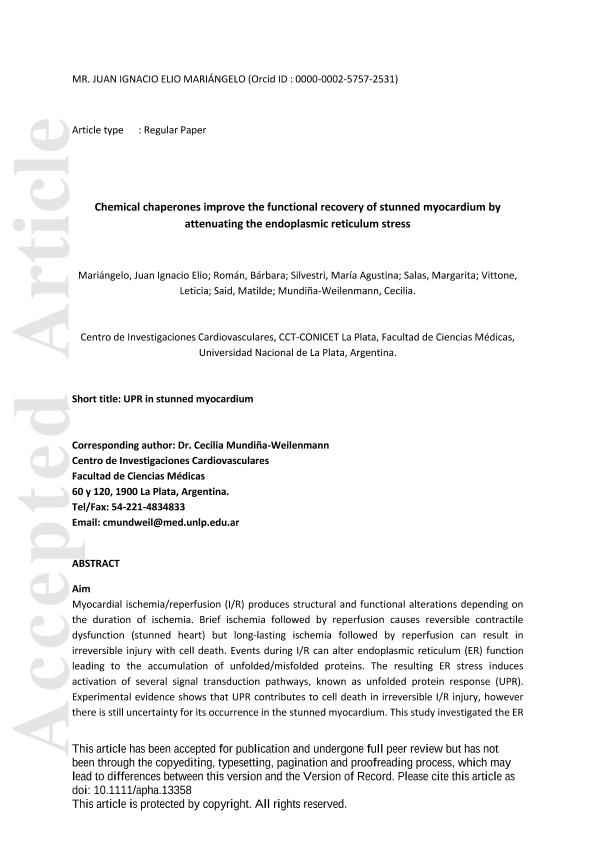Artículo
Chemical chaperones improve the functional recovery of stunned myocardium by attenuating the endoplasmic reticulum stress
Mariángelo, Juan Ignacio Elio ; Roman, Barbara Soledad
; Roman, Barbara Soledad ; Silvestri, María Agustina; Salas, Margarita Ana; Vittone, Leticia Beatriz
; Silvestri, María Agustina; Salas, Margarita Ana; Vittone, Leticia Beatriz ; Said, Maria Matilde
; Said, Maria Matilde ; Mundiña, Cecilia Beatriz
; Mundiña, Cecilia Beatriz
 ; Roman, Barbara Soledad
; Roman, Barbara Soledad ; Silvestri, María Agustina; Salas, Margarita Ana; Vittone, Leticia Beatriz
; Silvestri, María Agustina; Salas, Margarita Ana; Vittone, Leticia Beatriz ; Said, Maria Matilde
; Said, Maria Matilde ; Mundiña, Cecilia Beatriz
; Mundiña, Cecilia Beatriz
Fecha de publicación:
05/08/2019
Editorial:
Wiley Blackwell Publishing, Inc
Revista:
Acta Physiologica
ISSN:
1748-1708
Idioma:
Inglés
Tipo de recurso:
Artículo publicado
Clasificación temática:
Resumen
Aim: Myocardial ischaemia/reperfusion (I/R) produces structural and functional alterations depending on the duration of ischaemia. Brief ischaemia followed by reperfusion causes reversible contractile dysfunction (stunned heart) but long-lasting ischaemia followed by reperfusion can result in irreversible injury with cell death. Events during I/R can alter endoplasmic reticulum (ER) function leading to the accumulation of unfolded/misfolded proteins. The resulting ER stress induces activation of several signal transduction pathways, known as unfolded protein response (UPR). Experimental evidence shows that UPR contributes to cell death in irreversible I/R injury; however, there is still uncertainty for its occurrence in the stunned myocardium. This study investigated the ER stress response and its functional impact on the post-ischaemic cardiac performance of the stunned heart. Methods: Perfused rat hearts were subjected to 20 minutes of ischaemia followed by 30 minutes of reperfusion. UPR markers were evaluated by qRT-PCR and western blot. Post-ischaemic mechanical recovery was measured in absence and presence of two chemical chaperones: tauroursodeoxycholic acid (TUDCA) and 4-phenylbutyric acid (4-PBA). Results: Analysis of mRNA and protein levels of various ER stress effectors demonstrated that different UPR signalling cascades, involving both pro-survival and pro-apoptotic pathways, are activated. Inhibition of the UPR with chemical chaperones improved the post-ischaemic recovery of cardiac mechanical function without affecting the I/R-induced increase in oxidative stress. Conclusion: Our results suggest that prevention of ER stress by chemical chaperones could be a therapeutic tool to limit deterioration of the contractile function in clinical settings in which the phenomenon of myocardial stunning is present.
Archivos asociados
Licencia
Identificadores
Colecciones
Articulos(CIC)
Articulos de CENTRO DE INVEST.CARDIOVASCULARES (I)
Articulos de CENTRO DE INVEST.CARDIOVASCULARES (I)
Citación
Mariángelo, Juan Ignacio Elio; Roman, Barbara Soledad; Silvestri, María Agustina; Salas, Margarita Ana; Vittone, Leticia Beatriz; et al.; Chemical chaperones improve the functional recovery of stunned myocardium by attenuating the endoplasmic reticulum stress; Wiley Blackwell Publishing, Inc; Acta Physiologica; 228; 2; 5-8-2019; 1-20
Compartir
Altmétricas



